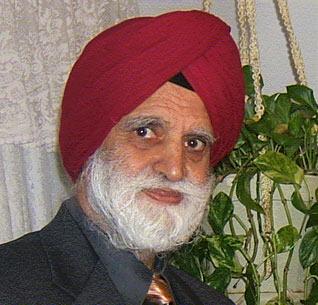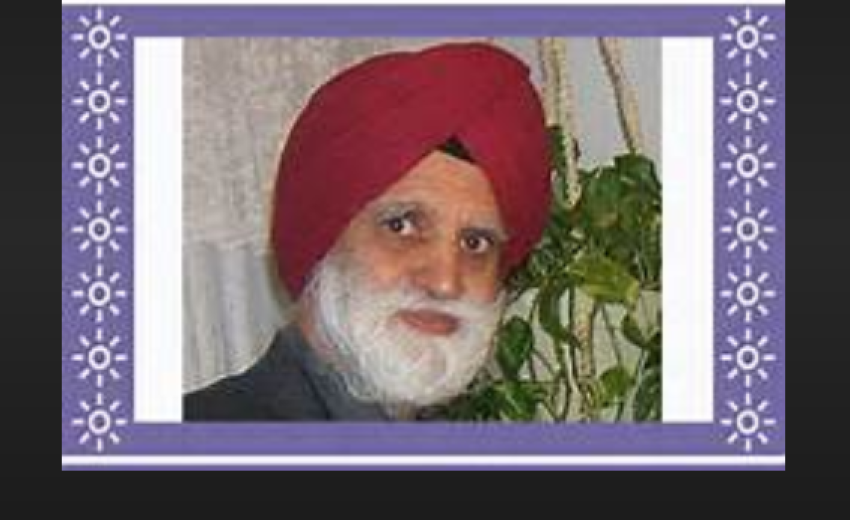 Dr. I.J. Singh looks like a traditional Sikh uncle or elder, but his ideas are anything but traditional. I would consider him one of the most progressive, contemporary Sikh thinkers alive today. His ideas are insightful and thought-provoking. I consider his numerous articles and three published books required reading for Sikh youth around the world. I included one my favourite articles below.
Dr. I.J. Singh looks like a traditional Sikh uncle or elder, but his ideas are anything but traditional. I would consider him one of the most progressive, contemporary Sikh thinkers alive today. His ideas are insightful and thought-provoking. I consider his numerous articles and three published books required reading for Sikh youth around the world. I included one my favourite articles below.
A Sikh au Courant
I.J. Singh
We all want to be modern. There is nothing quite so distressing as to be told that one is behind the times or is clueless about the world in which he or she operates. It is worse than being poor, fat or ugly. But what is it to be modern? What does being modern mean? Let me illustrate my concerns by two little tales.
Not so long ago, a young Sikh technocrat and I were passing the time of day over a cup of coffee. He is a bright MBA and a good man but not a recognizable Sikh. All of a sudden he blurted out: "We Sikhs have a very practical and logical religion with an incomparably attractive and modern worldview but our external appearance is not consistent with that modern framework." He was pointing to the turban and bearded visage of the observing Sikh male.
Another incident is from a few years ago when I was single. Some kind friends tried to set me up with a Sikh lady in a different town and gave me her telephone number. She was a bright, young, professionally educated Sikh - a psychiatrist.
We talked a few times on the telephone. Here, we both thought, might be some possibilities. Naturally, we wanted to meet face to face to see what kind of chemistry might result. We hadn't yet met and didn't know what the other looked like. One day, we were on the phone chatting about the logistics of meeting, when she abruptly inquired: "Are you a modern Sikh?"
I knew what she was about but decided to play it for what it was worth. To me, the antithesis of being modern is to be primitive. So, my response turned out to be somewhat tactless but not entirely pointless. I countered that I never ever left the house without clothes, could coherently converse on a variety of subjects including religion, politics and sex, and knew which fork to use with which plate at dinner; therefore, I was not exactly primitive. She thought my response was aggressively, if not offensively, unresponsive; she had wanted to know if I was keshadhari, long-haired Sikh or not. I thought a crew cut would not necessarily endow me with the so-called characteristics of modernity, anymore than long hair would automatically transform me either into a sage or a savage. Needless to say we never met.
I must confess that in both encounters - with the lady psychiatrist and the MBA - initially I was somewhat taken aback but, upon reflection, realized that perhaps this is how most of the world thinks of us. I see that many Sikhs also seem to reason similarly; that says something for our sense of self and the self-imposed psychological burden that many Sikhs seem to carry. The question, of course, is less how others view us, even though that is extremely important but, more significantly, how comfortable we are with whatever we have chosen to be.
My cohorts in both encounters insisted that Sikh philosophy and precepts were modern. (Did they really know enough of Sikh tradition to so assert or were they only mouthing the words? I merely raise the question here.) Nevertheless, if I accepted their protestations then the unassailable definition of modernity for a Sikh would be to understand and live by the very modern tenets and postulates of Sikhism. And would that not, I wondered, include the lifestyle of a Sikh, including one's appearance as one? It seems to me a very clear outcome of their logic on the modernity of Sikhism.
But in common parlance - in proposing such a conditional definition of modernity implied by my friends - we usually mean only the principles of Sikhism that should govern our everyday reality - trade, family and at most the ethical framework of our existence. But in such reasoning both of my friends have created a rift between the postulates of Sikhism and their historical manifestation in the individual Sikh with his articles of faith, including the unshorn hair. This dichotomy states that other rules of the game - such as the ones that dictate our outer garb - are an entirely different matter and perhaps irrelevant and immaterial.
In this view, the external appearance of the male Sikh is not consistent with the ways of the world, as we know it, hence not in keeping with the times. Seriously, I have come across several fresh arrivals from India who said to me: "On the phone you leave a different and more modern impression. But I see that you look like a traditional Sikh, something we didn't expect after so many years." I wonder what they were really thinking.
There are several ways to explore this paradoxical situation and many levels of objections to such an attitude that seems to select some rules as applicable while branding others as extraneous. Qualitatively, there are at least two kinds of argument that I can muster to dismiss such reasoning.
One can sensibly suggest that the Sikh appearance was not decided by a people after some sort of a referendum but was willed to them by their Guru. Surely these articles of faith are not at all like corporate logos that are redesigned periodically by a professional team of consultants after a survey and market-analysis of the current trends and fads.
Now, one can choose either to walk the path of the master or not - that choice is always available. But to walk while continuing to quibble full force reminds me of the adage "faint heart never climbed a mountain." (Or was it faint heart never won a fair lady, but let's not be sexist.) To sit around and second-guess the Guru's intention and how he might have decided if he had lived in this 21st century is a game with no rules or one where every player makes his own rules.
It reminds me of many students who protest that the rules and requirements of the course that I teach are onerous, unfair and demanding, but this protest occurs during mid semester usually after a harrowing and hopeless test and is primarily limited to those who are floundering. That's when the rules no longer appear convenient or helpful to the learning process but loom as a hurdle to their graduating. Students look only at the fact that the rules impose hardships on them or set them apart from other friends who may not be in a similarly demanding program. On the other hand, I am aware of the role my students are destined to play as health professionals and I must design the rules of the game that will prepare them for such responsibility. Inconvenient the rules may be but are they necessary? If necessary then they are also eminently fair. To demand less would not be doing justice to the professional choices these young people have made in life.
I am not unmindful of the social isolation and the economic repercussions that many Sikhs fear their appearance might produce. The other side of the coin raises an interesting issue: what insecurities in me suggest that life would be so much rosier if only I looked like John Doe? If such attitudes reside in me and govern my outlook in life it must be difficult indeed to look in the mirror. Life has taught me that no matter what I look like there will always be some who will not like me while there will be others who will accept me as I am. For many, I will always remain too short or too tall, too fat or too thin, too dark or too pale, too this or too that. No matter how smart I am there will be millions who will be smarter and just as many who will not be. No matter how rich I am…. and so on, ad infinitum. Whether it is in personal relationship or in social and professional interaction there is always a glass ceiling. But is it the result of our own inadequacies or those of others? Perhaps a little of each.
If I truly feel uncaged and free only when dressed in a particular manner then the problem lies primarily in my head, not in others. No one can make me feel small without my consent. So to look for an excuse or explanation in the demands of society is really not meaningful. Also, such demands can never be settled in full. My sense of self must be pretty feeble if it depends primarily upon my button down collar, wing tip shoes, blow-dried hairstyle or, most importantly, the opinion of others. I know the requirements of the corporate culture but my bonus is finally determined more by my production figures and only minimally, if at all, by my spit-shined shoes.
I know full well the pitfalls in taking the road less traveled. I also know that Sikhs are a minuscule minority in any part of the world, even in the Indian culture, except perhaps in Punjab. I know the situation is not likely to change. I am also convinced that Guru Gobind Singh, when he ordained the Khalsa, never had any expectation that there would ever be more Khalsa than there are people of other kind in the world. We are ordained to remain a minority. We have to learn to rejoice in this and not try to metamorphose into a brown sahib. For instance, there will never be more of any kind of people in this world than there are Chinese but that is no reason why everyone has to look Chinese or ape their very rich culture.
The five symbols of our religion, including the long unshorn hair, become articles of faith only when their magic and historical impact become integrated into our lives and embedded in our psyche such that they define us. Otherwise they remain symbols that can be discarded as and when the spirit moves us. As articles of faith they become a part of the self and good people will fight and die for them but not abandon them. As symbols they will always leave us uncomfortable and ill at ease. Symbols have a price; they can be bought and sold in the marketplace. As articles that define faith they acquire value which is often greater than life itself; they can't be weighed and measured in the market, nor do they become shop-worn. Then the question of their being with the times or not becomes silly as would a question that demands to know the price, justification or relevance of any part of the self.
Parenthetically, I wish to leave with you one thought. Look closely at these five articles of faith in Sikhism. You will see that they have undergone transformation with time, some more than others. I have attempted a fuller discussion on this elsewhere and it is not pertinent here.
Even though, and perhaps especially because they were so few, the challenge for Sikhs was always to remain undaunted and to walk the razor's edge of their faith with courage, confidence and a smile. In other words to live life fully, not by half measures. That was, perhaps, the meaning behind Guru Gobind Singh's challenging call for a head on Vaisakhi 1699. This is maybe the lesson that emerges from the sacrifices of Guru Arjan, Guru Tegh Bahadur and countless Sikh martyrs that history has honored. This is what Guru Nanak may have meant when he challenged his followers to walk with the head in the palm of the hand. I would think that to be able to put your head on the line for principle is an utterly modern concept that only a free people can adopt.
To live free is to be modern. This implies the courage to be distinct and to walk the different beat of your distant drummer. Look back, perhaps not so many years in your life, and what do you see? During adolescence when life was driven by raging hormones, the most powerful urge - not always clearly seen - was to define one's own self by being different from everyone else. (I know that this drive was also accompanied and backed by another - to belong to a pack, which emerged from the fear of being alone.) The sense of self - indeed our identity - developed out of the complex interplay of these competing desires and directions.
We spend our defining years learning to become individually distinct. In selecting what we wear or carry, we spend our teen years trying to make a unique statement. I am my own person, we want the world to know. It doesn't matter if the world thinks it's ridiculous but dyeing pink a swath down the middle of the head makes me unique, so that's what it will be. I want to be alone on my path but not lonely, so I look for a ratpack that travels together, where each enhances the other's emerging individuality. I also search for a badge that stamps me as exclusive - a limited edition - by joining exclusive clubs and secret societies.
In Sikhism, the Guru gave us the gift and the courage to stand out and yet to belong to a rich, powerful and eloquent tradition. I can't imagine a more fittingly modern idea. The question is how to model our lives so that our difference makes a statement. And then the question is what kind of a statement do we wish to make.
We are an integral part of society and so are integrated into it. Being like others defines the niche to which we belong - a space that is carved out of a shared history. By attaching ourselves to the timelessness of a heritage we become free of the restraint as well as of the tyranny of changing customs and changing times. Would the slavery to fad and fashion not make us prisoners of our time? And in the process would we not lose the sense of our heritage that makes us different and unique?
It is not always easy, even the concept isn't so easy to grasp. But I think the most expanded version of being in tune with the times would be - being the right person at the right time in the right place for the right reason.
Extracted from the author’s book “Being and Becoming a Sikh” (pp. 9-16) published in 2003 by The Centennial Foundation, Canada

